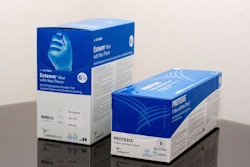
Rock Island, Ill.-based Hawk Technology has evolved with today's manufacturing requirements by planning, designing, building, and installing state-of-the-art robotic integration and tooling solutions around the world. From a single piece of tooling to an entire manufacturing facility, Hawk exceeds industry standards by providing the best in design, program management, and manufacturing services. A dramatic case-in-point is the company’s recent work for a major agricultural equipment manufacturer, in which Hawk’s new machine retrofit design for a hydraulic cylinder assembly bench resulted in production increases of 400 percent! That is NOT a typo.
Hawk does hydraulic cylinder assembly as an automated process. A hydraulic barrel cylinder and steel rod are presented to the automated equipment, which takes the process from there to completion. “As many as 14 axes of motion are involved, all at one time or in sequence,” says Josh Clare, president of Hawk Technology. “Speed becomes a pretty important factor when you have so much communication going on at one time.”
According to Clare, Hawk’s success in this arena began six or seven years ago, when it took a largely manual process and automated it using Omron Industrial Automation’s PLCs. “This took us from around a 4- or 5-minute assembly time down to the 1.5 or 2 minute range, using what I’ll call a ‘conventional PLC,’” he says. “Our customers have been demanding faster cycle times as a requirement; when EtherCAT came out, we wanted to try that technology for this new cylinder assembly bench.”
In this case, Hawk removed a five-servo axis GE Fanuc control system, retrofitted it with Omron CJ2M-CPU31 PLCs with a CJ1W-NC881 Position Controller Units with EtherCAT master, and replaced the drives with Omron servos.
“The old system didn’t have the ability to do torque-limited moves and change torque on the fly as we were doing it,” says Eric Larson, controls engineer at Hawk Technology. With the old system, torque could only be set once in the drive, which determined the maximum torque.
To ensure accurate positioning in the new system, Hawk built in a verification step that utilizes the ability to have one axis be torque-limited and have a non-torque limited axis follow it, tracking the actual cylinder based on feedback. If the rod couldn’t reach the target position based on torque, the following axis would follow the real-world positioning.
“It would keep the same offset,” explains Larson. “It wouldn’t move ahead as if the other axis were moving to where it was expected to be, but rather move based on where it was.”
Because the new machine was now tracking the drive, it provided all the information as it emerged: the torque feedback could be seen. The older system was analog control with encoder feedback into the control module, but provided no actual information from the drive. Using EtherCAT, Hawk got all the feedback from the drive, instantly, at the speed of the EtherCAT network.
“This let us change the assembly sequence around,” says Larson. “With the better control, we could change the assembly sequence to reduce assembly time. The customer could clearly see as it stepped from move to move how fluid and fast it was compared to the old process; it just flowed. It almost looked as if it wasn’t stopping between moves.”
The visual evidence was dramatically reinforced by time studies the customer conducted. “I’d describe the response as ‘shock and awe',” says Clare. “Before the retrofit, it took maybe 90 or 100 seconds to build a cylinder. Now we are seeing cylinders built in 17 seconds.”
Time to Rethink Possibilities
According to Clare, the improvements realized through the new machine have forced the user to rethink their production strategy. “This is one of the last machines in the whole process. Now, because of the speeds achieved, everything that feeds that cell is a bottleneck,” he says. “So they are rethinking their entire strategy. They need capacity and have the ability to sell product at volume. They just need to feed the beast.”
The customer knows that Hawk has the technology needed to provide enhanced feeder cells, and is working with them on accommodating these improvements moving forward.
The “Bleeding” Edge
Clare notes that working with Omron technology allows Hawk to be on the bleeding edge of machine development.
“That’s our sales pitch when we go into a customer,” he says. “We’re out in front of the cutting edge—we’re on the ‘bleeding’ edge. We’re doing a lot of things that other companies won’t attempt. It allows us to go into a meeting of managers and say, ‘you think you’re really fast now in assembling cylinders in 90 or 100 seconds? We can do it in 17 seconds.’ There’s a lot of disbelief initially. In this project, we told them that we could get the process down to 30 or 35 seconds, and we ended up at 17. This technology allows us to generate shock and awe as a competitive advantage.”
Larson adds that Omron Industrial Automation provides more than just a technological advantage. While Hawk knows the technology is great, they’ve also found (from a cost standpoint) that Omron Industrial Automation is extremely competitive while providing service, support, and parts availability—all of which can be just as critical as technology.
“Let me give you an example,” he says. “We’ve tried to order an emergency replacement part from another automation provider, and were told it would take a month. Omron typically has it in stock and we have it the next day—or even that day.”
“Parts availability is the kind of thing that sets us apart,” adds Clare. “We can have a customer go down and we’re able to get them up and running the same day. There aren’t too many companies in our business that can do that.”
Similarly, there aren’t many companies that can drive down production time in a manufacturing process by upwards of 80 percent!

























